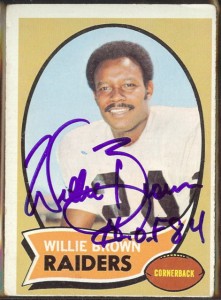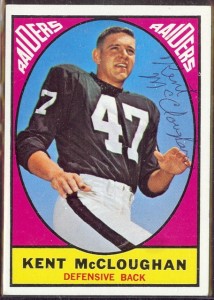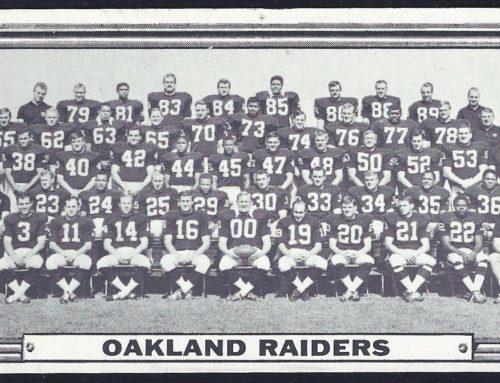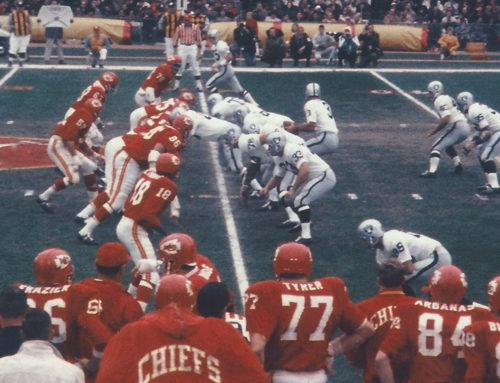Critics of the AFL often cited weak defenses as the source behind the league’s very potent offenses. Defensive schemes, they said, were weak, and secondaries, pathetic. They fail to give credit to a particularly potent defensive tactic that was put to great use by Al Davis and the Oakland Raiders. Dave Steidel takes a look at the bump and run.
The Bump and Run style of pass coverage is a strategy often used by defensive backs in which a defensive player lines up directly in front of a wide receiver and tries to impede him with arms, hands, or entire body and disrupt their intended route.
The bump and run came into pro football prominence in 1967 when Oakland Raider defensive back Willie Brown introduced it to the AFL. He started covering receivers at the line of scrimmage and without fear of being beaten deep he bumped and detoured receivers to the part of the field he chose for them. During this time in pro football the only time a defender had to be completely void of contact was when the ball was in the air. Until that time, physical contact was fair play.
Brown, a defensive back at Grambling was undrafted when he tried out for the Houston Oilers but got caught in a numbers game and was one of the last players cut. As word got out about Wood’s blanket coverage of Charlie Hennigan during scrimmages, the Denver rebuilding program was only too happy to bring him into their corral. In 1963 head coach Jack Faulkner had the Broncos in winning state of mind after they had challenged in the western division race for most of 1962. Faulkner had been on Sid Gillman’s staff at the University of Cincinnati and with both the LA/San Diego Chargers and the NFL Los Angeles Rams.
In the mid 1950’s while with the Rams as their defensive backs coach Faulkner had a recruit out of the University of San Francisco who made his name as a basketball specialist, K.C. Jones.
Jones was picked by the Rams as the 354th player drafted after he starred with Bill Russell on the NCAA basketball national championship team. He was also selected in the 15th round of the NBA draft by the Minneapolis Lakers. While with the Rams in training camp K.C. taught Faulkner his basketball style of tight man-to-man defense he thought would work to cover pass receivers, interrupting their flow and desired pass pattern the same way he would deny his basketball opponents. And while Jones’ time with the Rams was short lived, his impact on professional football far outlasted him.
With Denver, Faulkner taught the young Brown the close-up, physical style of defense, but it was never used in the Bronco scheme. When Lou Saban arrived in the mile high city and cleaned house following the 1966 season, Brown, now an all-league player for three years was traded to Oakland. It was in 1967 with the Raiders that Brown would finally get his chance to use the bump and run.
During training camp Brown taught the bump-and-run to Oakland’s other starting corner back, Kent McCloughan and the two became so successful at it that they sold coaching staff on it as well. As Brown and McCloughan began to jam up their surprised and baffled receivers on the line like never before, they did not let them stray into any sort of designed pattern, and the bump and run became the most talked about innovation of the year, along with it the Raiders laid claim to the AFL’s lowest pass completion percentage, 41%. The bump and run defense that Brown and McCloughan created and perfected was a trend setter, and was so overwhelmingly embraced and imitated by other teams over the years that it became nearly impossible for receivers to escape it. In 1978 the NFL changed the rule, making it illegal to come in contact with receivers beyond 5 yards of the line of scrimmage.
Willie Brown, is a member of the Pro Football Hall of Fame and is considered to be the father of the bump and run coverage. Together, he and Kent McCloughan revolutionized pass defending in football, but we must not forget to also give further credit where it is certainly due. We need to give credit to basketball Hall-of-Famer K.C. Jones for the blueprint.





The Patriots in recent years were using a modified type of bump and run in order to provide post 5 yard coverage. It was outlawed at the behest of the Colts. Peyton Manning had trouble getting open receivers.
The original bump and run was a good system but not flawless. During the 1970 AFC Championship game Unitas picked apart McCloughan. Willie Brown was successful at any scheme.
Played against Brown and McCloughan. Brown has had his skills recognized….always thought McCloughan, who I only played against man on man as a wide receiver one game, was really good at bump and run and a very under-rated player.
Just checked the 1967 pro-football reference site re all pro selections,,,Kent McCloughan was the consensus AFL all-pro at cornerback and Willie Brown was second team that year. Also, if my memory is correct, Kent suffered an injury that cut his career short and probably kept him from being recognized as one of the best corners of his time.
sorry to be so pervasive, but checked the 1966 all pro also http://www.pro-football-reference.com/years/1966_AFL/allpro.htm McCloughan was consensus 1st team and Brown (at Denver) was primarily 2nd team all pro….quite a combination when they teamed up with the Raiders for that 1967 season
further correction, McCloughan and Butch Byrd were the consensus AFL All Pros at corner in the AFL in 1966, Brown was still at Houston or Denver and didn’t make All-Pro that year. Dave Grayson and McCloughan were both Oakland all-pro corners, and Byrd at Buffalo , along with Speedy Duncan (Chargers), were the other premier corners. In ’67 McCloughan and Miller Farr were the consensus All Pro corners in the AFL. Willie came to prominence in the years subsequent. (I think I’ll let this one go now!)
McCloughan was injured vs the Raiders primary nemesis the Chiefs, in 1968. That ‘swimming(cess)pool’ the Raiders called a playing field not only slowed down the opposition somewhat but was also home to if not the direct cause necessarily some injuries.
Bad break for Kent, never quite the same again. No problem for the Raiders – least at the time, appeared. They simply went to their ‘well’ again, defined ‘depth’ & too the AFL equivalent of MLB’s KC Athletics, the Denver Broncos.
The A’s seemingly were the farm club to NY’s Yankees (trades for Roger Maris, others.) New Broncos Head Coach Lou Saban was in the midst another of his reclamation projects, this time in Denver… enter CB Nemiah Wilson.
An AFL All Star in 1967, Wilson was traded by Saban to OAK just as Lou had traded CB Brown to OAK the year before. Lou was on a roll: he also shipped CB Goldie Sellers to KC before the 1968 season as well FB Wendell Hayes & DT/NT Curley Culp,later; appears Hank Stram was also wise to the situation.
One of the consequences of McCloughan going down in ’68 was that the Raiders were forced or decided to play an rookie, George Atkinson at CB. Regular season, OAK’s 12-2 mark suggests they muddled by.
George was already a fine kick returner & became a fine S ongoing but having to face Namath & Maynard for example the AFL Championship game was too high a mountain to climb in hindsight (two big catches including a td).
It might have been no different had McCloughan been available as everything seemed to fall right for the eventual ‘World Champion’ Jets that magical year, ordinary tribulations aside.
________
* Btw Chris, STILL believe your foot was in bounds Superbowl 1 on that first sideline pass the official called out of bounds. As an aside, likely most folks have forgotten the Chiefs were an missed Mike Mercer field goal 2nd quarter from actually leading the Packers 10-7. That said might (or might not have) been an impetus/momentum toward a victory we’ll never know… I say ‘yes’. Who says Tex Maule is the only one who can show bias : )
no question about that first catch in Super Bowl I was in bounds, in my mind, the officials blew it and there was no replay in those days…stopped our momentum. Packers had some pass D vulnerabilities that we never fully exploited…Fleming who was on me most the time on the left side was a good corner as was Adderly on the right. We should have run the slot more as that’s where we could have done a lot of damage. I have some old film (now on dvd) of the game that I believe shows the first catch was good. You have a great memory to recall that! chris
The Packers corners were Bob Jeter and Herb Adderly. The Safety’s were Willie Wood and Tom Brown. Brown was the weak link of that quartet. He was “a student of the game”, not a great athlete. Two the the other three, Adderly and Wood are in the HOF.
I’d be interested in knowing the defensive weaknesses of the Packers. True, Dallas scored a lot of points on them in the NFL Championship Game, but, that defense has 5 members of the HOF.
My mistake…Jeter was the Packers right corner and very good, don’t know why I said Fleming as he was nother good player at LB. Sorry for the error and thanks for the correction….lots could be saif about SB I but we all have our own opeinions….would have loved to play them again the next day, but, you only get one chance and they won the day.
If that had happened (FG), then the final score would have been 35-13, instead of 35-10.
Howard, you put your finger on it, that’s why I said we should have run the slot more then one play, which was also completed just out of bounds, as Brown would be forced to cover the slot receiver and out of that great secondary, he was the one that we targeted in the films but never went after in the game. Glad to see you are on your toes!
Thanks Chris, I read a bit about you in the “10 Gallon War” book. Didn’t realize how talented the early Texans/Chiefs were. Also, didn’t know the animosity that Tex Schramm had against Lamar Hunt. Much more so than Hunt vs. Murchison.
I was 14 years old when I watched Super Bowl I. I was a big Packers fan as a kid. They were so fundamentally sound, that very few teams could beat them. The other team would always throw the interception or the stupid penalty. Today’s Patriots are similar, they don’t beat themselves.
Chris
Appreciate the reply. Your sentiment “would have loved to play them again the next day” was shared by some other Chiefs as I recall, including Buck Buchanan and Mike Garrett. I recall Len Dawson being unconvinced too, his comments re: GB’s supposed superiority. I concur x4 the aforementioned folks: one day as one game does not a consensus make. I would have loved to have seen those Packers in place of the Bears that August 1967 game in KC… the Chiefs might’ave scored 100 that night instead of only 66.
What most fans may not know is the Chiefs actually tried for two points after their last td & save for a bobbled snap by QB Pete Beathard, final score would have been 68-24. Were the Chiefs trying to make a point/rub it in? You bet… just like GB in SB I. Which is my point: setting, payback and momentum.
‘Mo’ as you say can be an powerful force. Another commenter scoffed at the the possibility that the Chiefs might have gained momentum by virtue taking the lead vs GB. From having been there at the game/had a sense how it transpired, a different game indeed was possible.
‘What if’s’ may be afterthought but McGee’s (with the help of Providence – not the one in Rhode Island) ‘answered prayer of a catch’ (even he admitted said) set the tone for that day. It was the final analysis mostly all south (and I don’t mean the Bahamas) thereaft KC, terms which team had good fortune its side.
Both SB I and II were not routs, unless one looks only at the final score (as if an game began same as it ended, final point margin.) There was genuine concern in the GB locker room at halftime, this according to their own players. Too, KC was reportedly confident going into that second half. “Shoot – we can win this game Coach… they (GB) aren’t anything like we thought!” (superhuman.)
A 21-10 lead till almost the very end the 3rd quarter (and a first half wherein KC outgained GB in yardage) is hardly indicative of superiority, GB’s. The 4th quarter, KC wore down according to reports (a couple GB players said KC had “a bunch of fat guys” re: conditioning.) GB’s experience & KC’s lack said (and the stage as twere, national spotlight) more than anything other the deciding factor, my opine.
GB was still trying to run up the score 4th quarter; they’d been predicted by ‘NFL types’ (naturally) to win 50-0 or 60-0. KC CB Willie Mitchell stole a long Starr attempt at a bomb 4th quarter, KC never giving up, ‘in’experience the difference the game, veteran team vs young one, mystique trumping nerves.
Man for man (some individual cases/quickness aside certain players), the Chiefs were the bigger, stronger faster team than GB (ditto OAK in SB II /Colts in SB III. Interestingly, wasn’t until SB IV when the bigger, stronger faster team – Chiefs – won.
Found it worth a chuckle that Lombardi was actually (to be polite) ‘sweating bricks’ before the game about facing the Chiefs, pressure from NFL owners etc. CBS announcer Frank Gifford said Lombardi was actually ‘shaking’ before the game.
I believe the Packers were /remain the best ‘team’ in pro football history, at least based on results ‘a given day, Championship games’, their whole being greater than the sum its parts. That said, I’ve no doubt had the Chiefs played GB again as you say, a different outcome…ditto SB II and the Raiders (another game that was in doubt until well into the 2nd half.) Though I’m an AFL fan & applauded the Jets SB III win, I suspect that much as SB I & II would be different, the Colts might very well win their fair share – or more – were those 2 teams to play again the next day, and several times thereafter.
Appears SB IV’s Chiefs left no doubt, even in Lombardi’s mind… he looked a bit sour up in the stands while watching the AFL prove that NFL dominance was ‘a myth’, now in deed as it had been in long held opinion.
Again, thanks for the reply.
Great recap on the game and atmosphere Howard….you’ve brought back lots of fun memories for me and others….regards, Chris
I’m not sure if the NFL was superior to the AFL during the last half of the 1960’s (the first half of 1960’s I’m absolutely convinced), but, I am 100% convinced that the Packers were the best and better team in Super Bowl I. I’m not saying they were 35 points better. But, if the 1966 Chiefs played the 1966 packers 10 times, I would say Green Bay would win 7 or 8 times. Look at the rosters; regardless of NFL bias, the Packers had 9 HOF members (Starr, Taylor, Gregg, Jordan, Davis, Nitshcke, Adderly, Wood, Lombardi). The Chiefs were a fine team, but, not as good as the Packers.
And one of the myths about the AFL was that they were significantly more offensive minded than the NFL. In reality, during the 1960’s both leagues were offensive minded. This blog had stats recently indicating that AFL and NFL rushing and passing attempts per game were quite similar by the mid 1960’s. In fact the Packers by 1965 became much more of a passing than running team. Their yard per carry rushing dropped dramatically from the 1961-1963 teams that were famous for the power sweep.
By 1966 Bart Starr was the most efficient passer in pro football. If not for him and his 104 QB rating all time postseason, they could not have won relying on a running game.
Your’re welcome for my 2¢ Chris (I’m not sure ‘Howard’ will agree, but then my comments don’t agree with his take either re: GB dominance : )
Now I’ll stop (for awhile) before Todd thinks I’ve hijacked his blog…
Nope. This is the best comment banter that we have had on any story yet. I would be thrilled if every story got this much interaction. By all means, keep going!!!
ditto for me 1967……………..
I wonder what made KC Jones expendlble to the Rams, obviuosly it is a numbers game and he did lack football experience after he was drafted by LA in 1955 as an Offensive End. In 1956 KC with Bill Russell were members of both the NCAA Championship USF Dons and the US Olympic Gold medal winning basketball team in Melbourne.
In 1956 and 1957 the Rams got lucky an drafted a few talented players, which may explain KC’s demise, although who knows, KC may have told the Rams he decided to take his talents to the NBA. The players the Rams added to trhe OE and DB position those two seasons included Jesse Whittendon who compliment and already steady defensive backfield that included Will Sherman, Don Burroughs and in 1957 LA drafted Del Shofner as a db who played on that side of the ball his rookie year and then moved to OE in 1958 where he eventually garnered All Pro honors, in LA and with the Giants in NY. Also in 1957 they drafted OE Jimmy Orr who like KC never played a down with the Rams and in 1957 Rams rookie Jon Arnett the number two pick in the entire 1957 Draft was moved to flanker to replace injured Elroy!!!! Crazy Legs Hirsch a move that proved disatrous for the Jaguar as he has written that the “Dutchman” was hated rookies especially Arnett, thought him to be to good looking and over paid especially for a rook and wouldn’t throw him the ball.
I also learned something reviewing the 1956 NFL Draft lists. The 1951 LA City High School Player of the Year running back Jerry Drew a high school teammate of Rommie Loudds’ at Jefferson attended Cal Berkeley and like Rommie and another LA kid RC “Alley Oop” Owens were was drafted together that same year by the San francisco 49ers. Jerry like KC never played a down in the NFL other than possibly in the pre season…not sure.
Awesome recap of 1950’s LA environment!! You are a great student of that time period. Very informative.
Pete Rozelle who in 1957 was promoted from Rams publicist to GM played a major role in acquiring KC Jones. Pete was a USF Alumni and KC may have been signed as Dave seems to suggest as a demonstration player, with either no real intention of playing football or as a project that never materialized. By the end of the 1950’s the Rams had three superior receivers in Shofner, Carrol Dale and my childhood favorite Jim Red Phillips. To give you some idea of how good a running back Jerry Drew was, one need look no further than to his one and only season 1954 at Cal, he was a Juco transfer, and that Junior season Jerry averaged 9.3 yards per carry, gaining 854 yards on 88 carries. Kenny Grahams high school and later college coach Jim Sutherland was a Pappy Waldorf assistant at Cal in 1954 and was instrumental in Jerrys recruitment, but like a lot of guys may not have liked the school thing, got hurt or for” whatever” after 1954 ” The Great” Jerry Drew walked away from incomparable numbers and Cal for good.
I first started watching pro football in 1963. Living in New Haven, the “home’ team was the Giants. I remember watching Shofner play. He ran brilliant patterns and he had great hands. Not a big guy, kind of a Wes Welker of his day.
Carroll Dale was another excellent receiver. He and Bowd Dowler were both rangy and smart receivers.
Dale and Dowler were both excellent…Dowler (I think…as I was chagrined for my earlier error, re Jeter, and it later dawned on me that Fleming (Marv) was the tight end for the Pack) got hurt early which enabled McGee to get in and have the marvelous game he had.
Dowler separated his shoulder two weeks earlier against Dallas. He got popped on the first play and McGee came in. Legend has it that McGee was seen coming into the Packers hotel at 7:00AM on Sunday. Apparently he was hydrating all of Saturday night.
Later in the game Fred Williamson (The Hammer) was knocked out diving for Donnie Anderson, the $600,000 man. Someone on the Packers sideline asked how The Hammer got knocked out? McGee said that Anderson hit The Hammer with his wallet.
… [Trackback]
[…] Info to that Topic: talesfromtheamericanfootballleague.com/the-bump-and-run-boys-willie-brown-and-kent-mccloughan/ […]
… [Trackback]
[…] Find More Information here on that Topic: talesfromtheamericanfootballleague.com/the-bump-and-run-boys-willie-brown-and-kent-mccloughan/ […]
… [Trackback]
[…] There you can find 26626 additional Info to that Topic: talesfromtheamericanfootballleague.com/the-bump-and-run-boys-willie-brown-and-kent-mccloughan/ […]
… [Trackback]
[…] Info on that Topic: talesfromtheamericanfootballleague.com/the-bump-and-run-boys-willie-brown-and-kent-mccloughan/ […]
… [Trackback]
[…] Read More Information here on that Topic: talesfromtheamericanfootballleague.com/the-bump-and-run-boys-willie-brown-and-kent-mccloughan/ […]
… [Trackback]
[…] Info on that Topic: talesfromtheamericanfootballleague.com/the-bump-and-run-boys-willie-brown-and-kent-mccloughan/ […]
… [Trackback]
[…] Info to that Topic: talesfromtheamericanfootballleague.com/the-bump-and-run-boys-willie-brown-and-kent-mccloughan/ […]
… [Trackback]
[…] Find More Info here on that Topic: talesfromtheamericanfootballleague.com/the-bump-and-run-boys-willie-brown-and-kent-mccloughan/ […]
… [Trackback]
[…] Find More Info here on that Topic: talesfromtheamericanfootballleague.com/the-bump-and-run-boys-willie-brown-and-kent-mccloughan/ […]
… [Trackback]
[…] Here you will find 9010 additional Information to that Topic: talesfromtheamericanfootballleague.com/the-bump-and-run-boys-willie-brown-and-kent-mccloughan/ […]
… [Trackback]
[…] Read More here on that Topic: talesfromtheamericanfootballleague.com/the-bump-and-run-boys-willie-brown-and-kent-mccloughan/ […]
… [Trackback]
[…] Find More on that Topic: talesfromtheamericanfootballleague.com/the-bump-and-run-boys-willie-brown-and-kent-mccloughan/ […]
… [Trackback]
[…] Information to that Topic: talesfromtheamericanfootballleague.com/the-bump-and-run-boys-willie-brown-and-kent-mccloughan/ […]
… [Trackback]
[…] Find More Information here to that Topic: talesfromtheamericanfootballleague.com/the-bump-and-run-boys-willie-brown-and-kent-mccloughan/ […]
… [Trackback]
[…] Information on that Topic: talesfromtheamericanfootballleague.com/the-bump-and-run-boys-willie-brown-and-kent-mccloughan/ […]
… [Trackback]
[…] Read More Information here to that Topic: talesfromtheamericanfootballleague.com/the-bump-and-run-boys-willie-brown-and-kent-mccloughan/ […]
… [Trackback]
[…] Info to that Topic: talesfromtheamericanfootballleague.com/the-bump-and-run-boys-willie-brown-and-kent-mccloughan/ […]
… [Trackback]
[…] Here you can find 35442 additional Information to that Topic: talesfromtheamericanfootballleague.com/the-bump-and-run-boys-willie-brown-and-kent-mccloughan/ […]
… [Trackback]
[…] Information on that Topic: talesfromtheamericanfootballleague.com/the-bump-and-run-boys-willie-brown-and-kent-mccloughan/ […]
… [Trackback]
[…] Find More Info here to that Topic: talesfromtheamericanfootballleague.com/the-bump-and-run-boys-willie-brown-and-kent-mccloughan/ […]
… [Trackback]
[…] Find More on to that Topic: talesfromtheamericanfootballleague.com/the-bump-and-run-boys-willie-brown-and-kent-mccloughan/ […]
… [Trackback]
[…] Read More Info here to that Topic: talesfromtheamericanfootballleague.com/the-bump-and-run-boys-willie-brown-and-kent-mccloughan/ […]
… [Trackback]
[…] Read More on that Topic: talesfromtheamericanfootballleague.com/the-bump-and-run-boys-willie-brown-and-kent-mccloughan/ […]
… [Trackback]
[…] Read More on that Topic: talesfromtheamericanfootballleague.com/the-bump-and-run-boys-willie-brown-and-kent-mccloughan/ […]
… [Trackback]
[…] Here you will find 54396 more Info on that Topic: talesfromtheamericanfootballleague.com/the-bump-and-run-boys-willie-brown-and-kent-mccloughan/ […]
… [Trackback]
[…] Here you can find 84516 more Information on that Topic: talesfromtheamericanfootballleague.com/the-bump-and-run-boys-willie-brown-and-kent-mccloughan/ […]
… [Trackback]
[…] Read More here on that Topic: talesfromtheamericanfootballleague.com/the-bump-and-run-boys-willie-brown-and-kent-mccloughan/ […]
… [Trackback]
[…] Find More Information here to that Topic: talesfromtheamericanfootballleague.com/the-bump-and-run-boys-willie-brown-and-kent-mccloughan/ […]